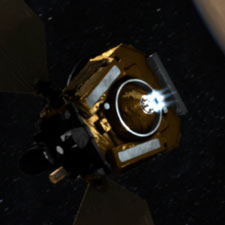
The Mars Reconnaissance Orbiter began aerobreaking in the Martian atmosphere on March 10th.
NASA / JPL
Score one more round for humanity against the dreaded Martian Ghoul ... at least for now. At 5:16 p.m. EST (22:16 UT) today, NASA received a signal from its Mars Reconnaissance Orbiter (MRO) confirming that the $710-million spacecraft had swung behind Mars and successfully fired its braking rocket for 27 minutes. Over the next few months, the 2,180-kilogram (4,806-pound) craft will periodically dip through Mars's tenuous upper atmosphere to "aerobrake" from its current highly elongated orbit into its planned 305-kilometer-high (190-mile-high) circular orbit.
The Martian "ghoul" is the mythical beast that has struck down about two-thirds of NASA and Soviet spacecraft from the 1960s to the late 1990s. Since then, planet Earth has made a stirring comeback. If MRO successfully enters its correct science orbit, it will join NASA's Mars Global Surveyor and Mars Odyssey and the European Space Agency's Mars Express orbiters, giving our species an unprecedented armada of four functioning spacecraft orbiting another planet. And NASA's Mars Exploration Rovers Spirit and Opportunity continue to amaze scientists and engineers by operating long past their designed lifetimes.
MRO's high-resolution camera will image rocks and other features as small as a kitchen table. Other instruments will provide unparalleled spectral resolution, allowing geologists to map Mars's mineral and chemical composition. MRO will return data to Earth at a rate 10 times greater than any previous Mars orbiter.
NASA launched MRO from Cape Canaveral on August 12, 2005. If all goes well with the aerobraking, the orbiter will begin science operations this November. But MRO will also be conducting important science during the aerobraking phase. "Our primary science phase won't begin until November, but we'll actually be studying the changeable structure of Mars's atmosphere by sensing the density of the atmosphere at different altitudes each time we fly through it during aerobraking," says MRO project scientist Richard Zurek (NASA/Jet Propulsion Laboratory).
The successful rocket burn comes at a critical point in the history of space science. Budget cuts by NASA administrators have wiped out major science missions and are devastating the agency's space-science program in general. These cuts threaten the destruction of an infrastructure built up over many years that has enabled missions like MRO to be developed, and which facilitated America's rise to the leadership role in planetary exploration and space-based astronomy.
 0
0
Comments
You must be logged in to post a comment.